With Conrail cleanup in rear view, Philly clearing new Kensington heroin camps
Some fear the approach could scatter homeless drug users around the neighborhood.
Listen 5:43-
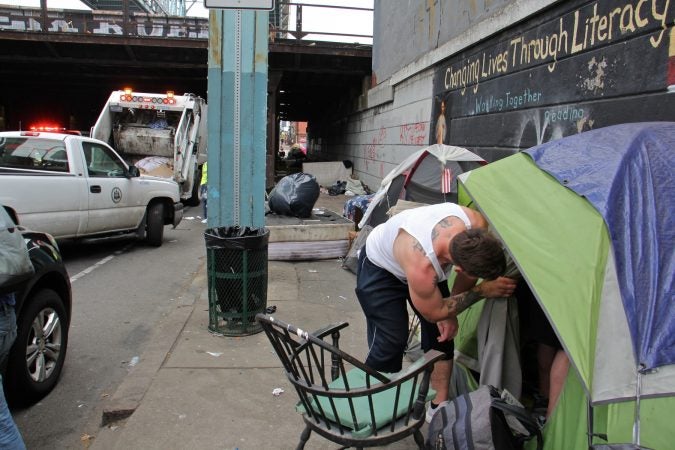
A visitor to the Kensington Avenue heroin encampment checks on a friend. (Emma Lee/WHYY)
-
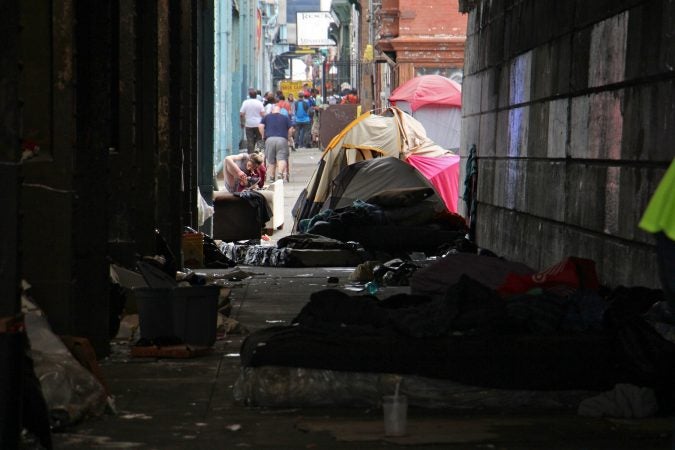
-
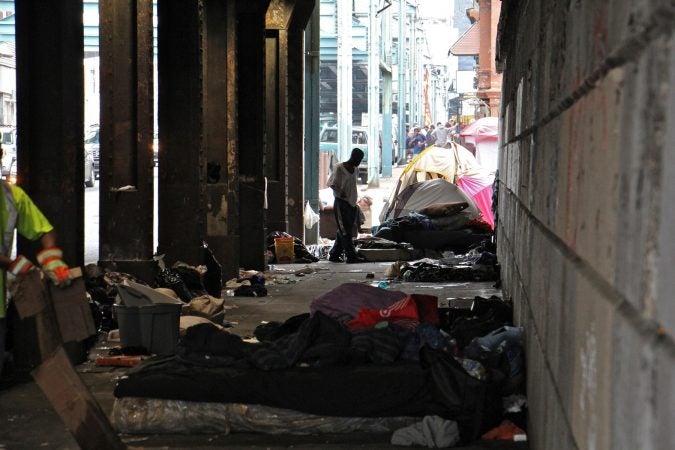
-
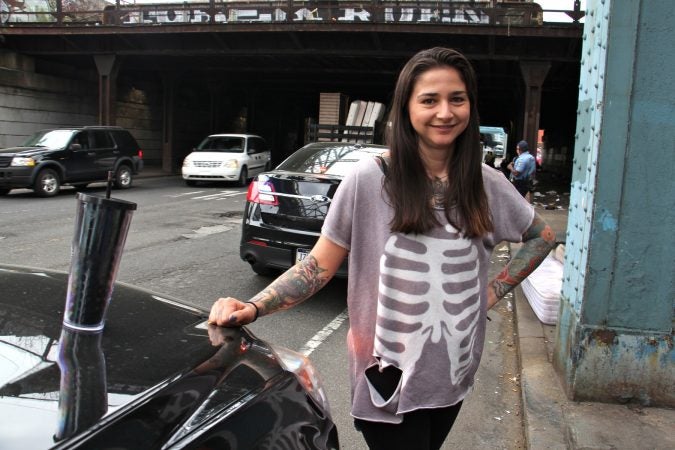
Outreach volunteer Nicole Bixler visits a camp at Kensington and Lehigh avenues. (Emma Lee/WHYY)
-
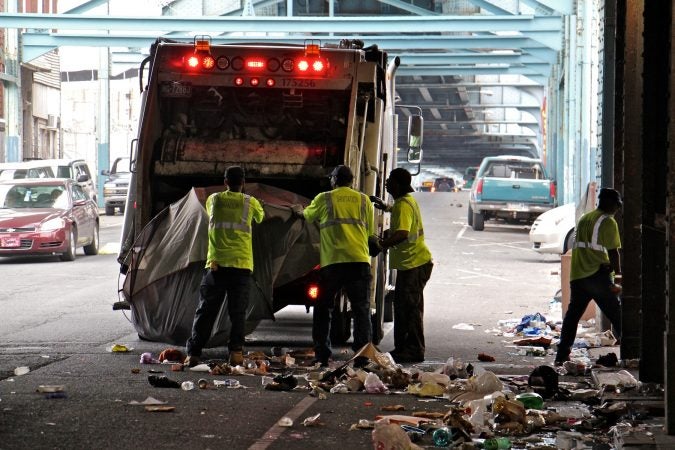
Sanitation workers clear away mounds of garbage from a heroin encampment at Lehigh and Kensington avenues. (Emma Lee/WHYY)
-
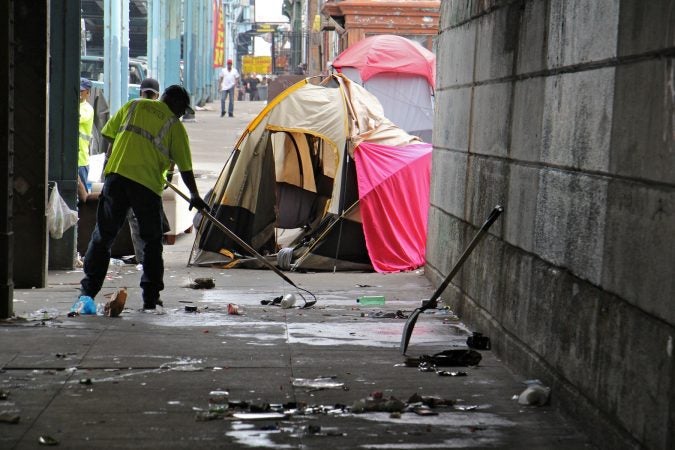
Sanitation workers clear away mounds of garbage from a heroin encampment at Lehigh and Kensington avenues. (Emma Lee/WHYY)
-
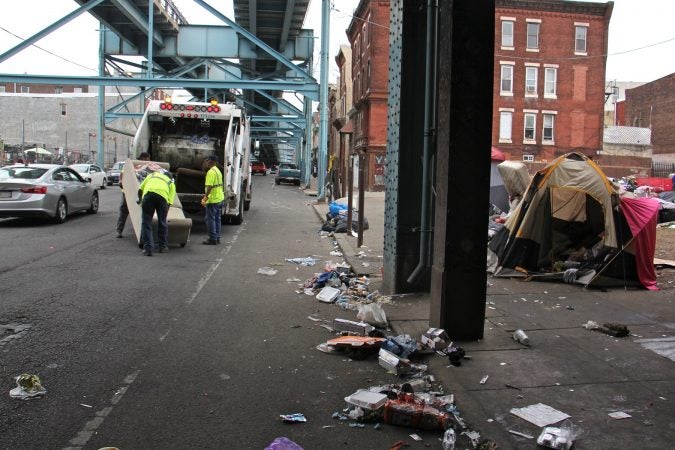
Sanitation workers clear away mounds of garbage from a heroin encampment at Lehigh and Kensington avenues. (Emma Lee/WHYY)
-

Needles litter the area under the Conrail tracks on Kensington Avenue. (Emma Lee/WHYY)
-
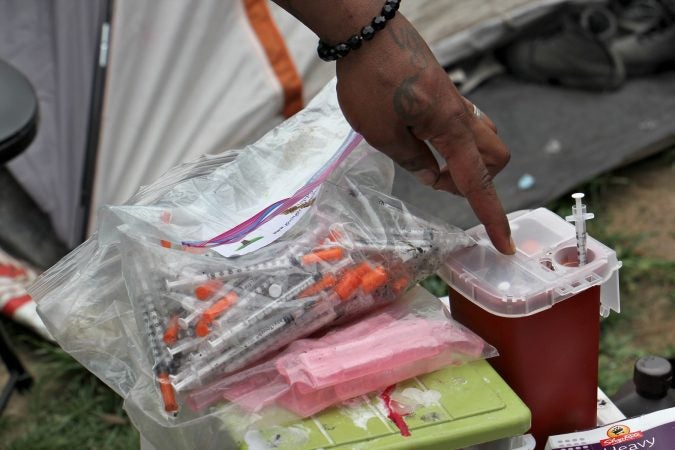
A resident of the Kensington Avenue encampment shows how he safely disposes of his used needles. (Emma Lee/WHYY)
-
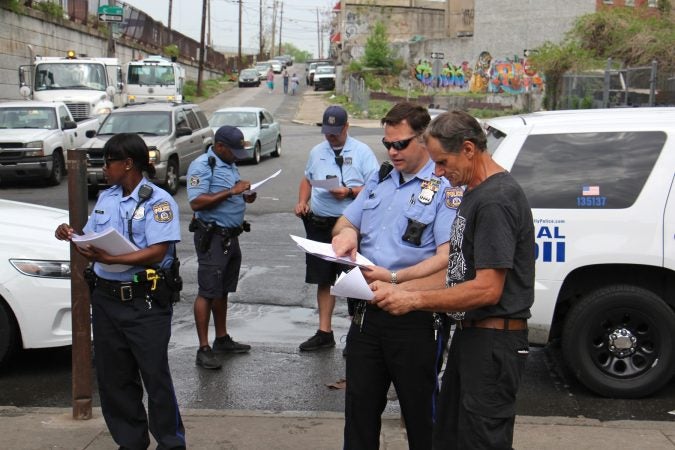
Police hand out flyers at Kensington Avenue and Tusculum Street, ordering residents of the heroin encampment there to leave by May 30. (Emma Lee/WHYY)
-
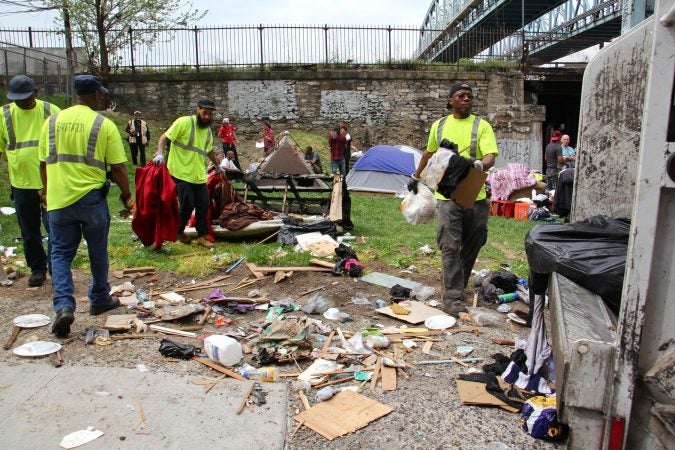
Sanitation workers clear away mounds of garbage from a heroin encampment at Lehigh and Kensington avenues. (Emma Lee/WHYY)
-
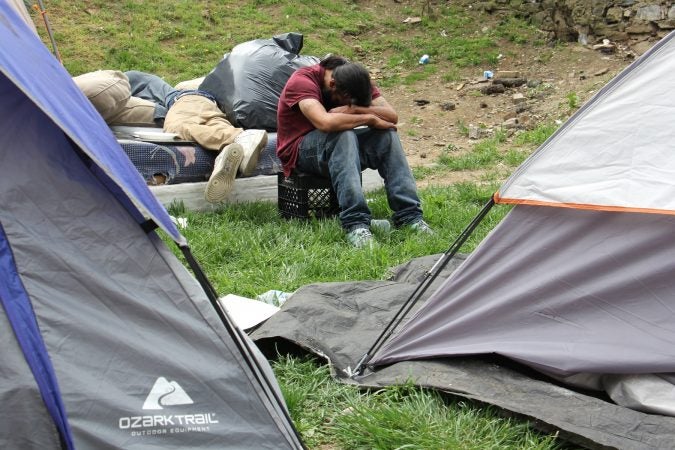
Residents of an encampment on Kensington Avenue wait with their possessions on a vacant lot while the city does a bi-weekly cleaning under the train overpass. (Emma Lee/WHYY)
-
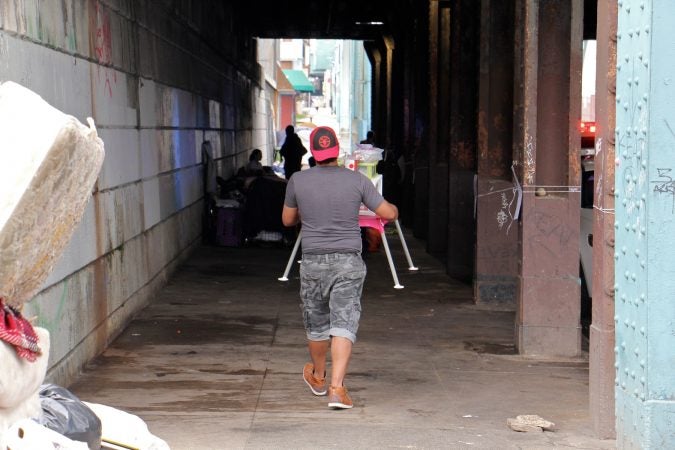
After city sanitation workers finish cleaning, campers move back under the railroad overpass. (Emma Lee/WHYY)
-
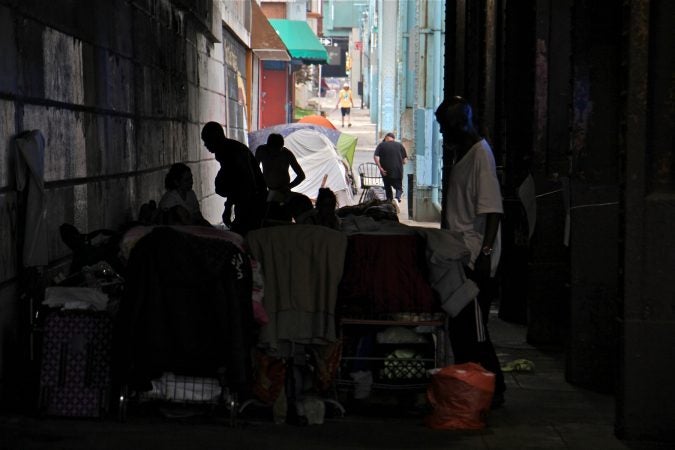
After city sanitation workers are done cleaning, campers move back under the railroad overpass. (Emma Lee/WHYY)
-
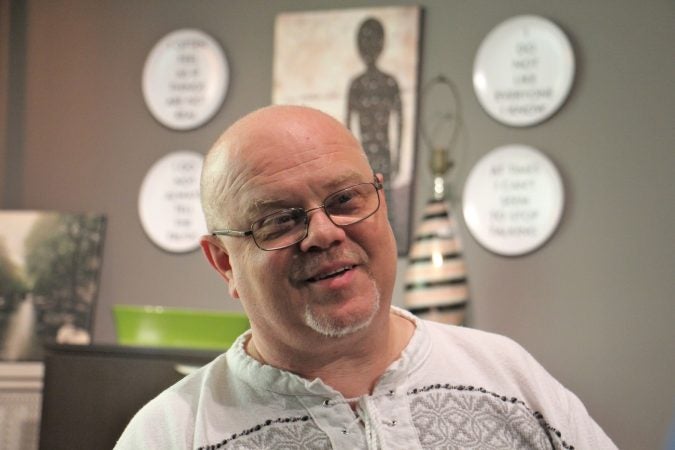
Prevention Point Executive Director Jose Benitez. (Emma Lee/WHYY)
-
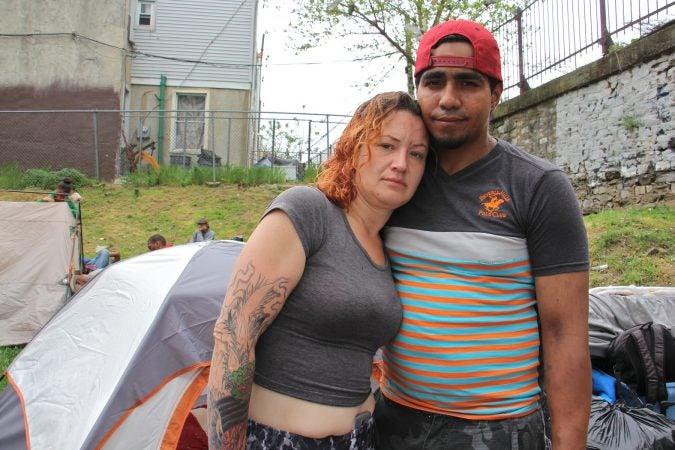
Salvatore Gonzalez and his fiancée stand in front of their tent near the Kensington Avenue railroad overpass, where heroin addicts have taken shelter since camp along the Conrail tracks near Gurney Street was shut down. (Emma Lee/WHYY)
On a recent Friday morning, a young man named John was sitting on a street corner down the block from a railroad bridge where people pitch tents along busy Kensington Avenue. He had a weary look on his face, a red gash on his forehead, and a harrowing story to tell.
“Some dude in a truck hit me in my tent,” John said.
A cluster of five staples held together a wound coated with dried blood at the edge of his full head of dark, wavy hair. But John said his girlfriend got the worst of the impact. The two of them were together inside the tent the previous morning talking about how to get to a clinic where she was starting addiction treatment.
“My girlfriend was closer to the street, so as soon as the impact happened, her upper body flung across kind of my lap and the truck hit me in the shoulder and the head,” John recounted.
He suffered a tear in his shoulder, and his girlfriend’s pelvis was broken in four places.
On that Friday, he was waiting for a ride to visit her in the hospital.
“I guess one of the tires had ran over her upper leg area, and that’s what caused the fractures,” John said.
John, who said he had unresolved criminal charges, didn’t want to give his full name. He said the pickup truck made a right turn off Lehigh Avenue onto Kensington Avenue — around the corner from where he sat — before veering off the road and striking his tent. The driver said his brakes had gone out, John said.
The Philadelphia Police Department confirmed the accident, saying a Ford F-150 struck a pillar of the El train tracks before hitting the pair on the patch of sidewalk where they dwelled.
Homeless for three months, John said he recently stopped using heroin and started treatment at a methadone clinic. The clinic has been trying to find him housing, but with his tent destroyed he wasn’t sure where he would end up.
“I just seem to be not having the best fortune or luck lately, but hopefully things will change,” John said.
City moves to shift 90 under bridges
By the end of May, all of the estimated 90 people living under this bridge on Kensington Avenue and another one a half mile away on Tulip Street will also have to find new places to go. The city launched what it’s calling a “pilot program” at the beginning of May to test its plan to clear the expanding tent cities that have put a strain on the neighborhood since last fall. The plan involves intensive, individualized outreach to get each camper off the street and into housing and treatment programs.
But some fear it could scatter homeless drug users around the neighborhood if the approach doesn’t work.
While John waited for his ride, sanitation workers were busy doing their twice-weekly cleanup of the Kensington Avenue encampment. Nicole Bixler chatted with encampment residents while idling garbage trucks gobbled up litter. A social worker who volunteers her time helping people here, Bixler said she didn’t think the city’s plan would work.
“What I predict is going to happen? This bridge will be cleaned out, Tulip will be cleaned out, they’ll go to the other bridges, they’ll go in abandoned buildings,” Bixler said. “The community will be broken up, and they’ll die alone, and no one will know until we smell them in the summertime.”
Bixler compared the plan with last year’s closure of the Conrail tracks, another place where drug users formed encampments and went to inject heroin. The city offered services to those who were displaced, but most refused the help. Neighborhood residents have complained that the closure has driven people addicted to opioids into more public areas where they now inject openly on the street. New encampments began forming last fall, and the city recently counted about 180 people living under four Kensington bridges along Lehigh Avenue.
But city officials say they’ve learned lessons from the Conrail closure, and they’re starting with two of four of the encampments to see how things go rather than tackling them all at once.
“What’s different now is we have organized resources that we believe are going to be equal to the need,” said Eva Gladstein, the city’s deputy managing director of health and human services.
Gladstein said the city is making enough shelter beds available to accommodate the roughly 90 people it counts living under the two bridges. That includes a new 40-bed shelter, or “respite,” located close to the encampments, which will take people in even if they’re not ready or able to start treatment.
Gladstein also said the city was eliminating delays to start addiction treatment by removing barriers such as the requirement to have identification.
Making shelter, treatment available
The city is working with harm-reduction organization Prevention Point to conduct outreach and operate the new respite, which will serve as a “navigation center” for people getting services. Executive director Jose Benitez said, so far, the city has backed up its promises. In the first week of outreach, he said, no one had been denied treatment services.
Still, Benitez said he’s not sure whether the city had enough beds in shelters and treatment programs to meet the demand at the two encampments.
“I think we’re going to learn that in this process,” Benitez said.
Some advocates are questioning whether now is the right time be clearing the encampments. The city announced months ago that it was pursuing supervised injection facilities to slow the rising tide of overdose deaths. They would provide a safe place to inject opioids, with trained medical staff who could revive people who overdose.
City officials say the “comprehensive user engagement sites” would also serve as places where people struggling with addiction on the streets could access treatment and housing.
Some supporters of the controversial sites say it would have been better have a new way to engage drug users before dispersing people at the Kensington encampments.
“To me it feels very backwards,” said Brooke Feldman, a social worker who has advocated for encampment residents at recent community meetings convened by the city.
Feldman worries it could be harder to reach homeless drug users if the encampment closures scatter them into abandoned buildings and other secluded places in the community. She fears that without as many others around to potentially rescue them from an overdose, they would be at greater risk of losing their lives to addiction.
“When people start to disperse, start using alone, start using in abandoned buildings,” Feldman said, “that’s when we start to see overdose deaths increase.”
‘It’s about time’
But many neighborhood residents are relieved that the city is finally taking action.
“It’s like, ‘it’s about time,’ ” said Gloria Cartagena, the president of the neighborhood association Somerset Neighbors for Better Living. “That’s what we all say. We can’t have this around here, needles and trash piling up everywhere.”
Cartagena’s group has been pressing the city since last fall to get drug users off the streets and out of view of neighborhood children.
As sanitation workers finished their cleanup of the Kensington Avenue bridge, and encampment residents began carting their belongings back into the shadows under its span, Salvatore Gonzalez Jr. considered his options. Addiction brought the 33-year-old heroin user to the city from Camden six months ago.
“I’m used to waking up in the morning and putting a needle in my arm,” he said. “How am I gonna live waking up in the morning […] and drinking coffee or going outside and yawning or something normal?”
Prevention Point was working to get him and his fiancée into a shelter and eventually more permanent housing, he said. He wasn’t sure whether he would take it, though. He had a couple of other options: check into long-term rehab or move into a room where an employer said he could live in exchange for doing maintenance work.
Gonzalez said he didn’t mind the pressure of the May 30 deadline to leave the encampment.
“Whether good or bad, I mean, we’re going to be forced to take another step. So that is a good thing.”
WHYY is your source for fact-based, in-depth journalism and information. As a nonprofit organization, we rely on financial support from readers like you. Please give today.





